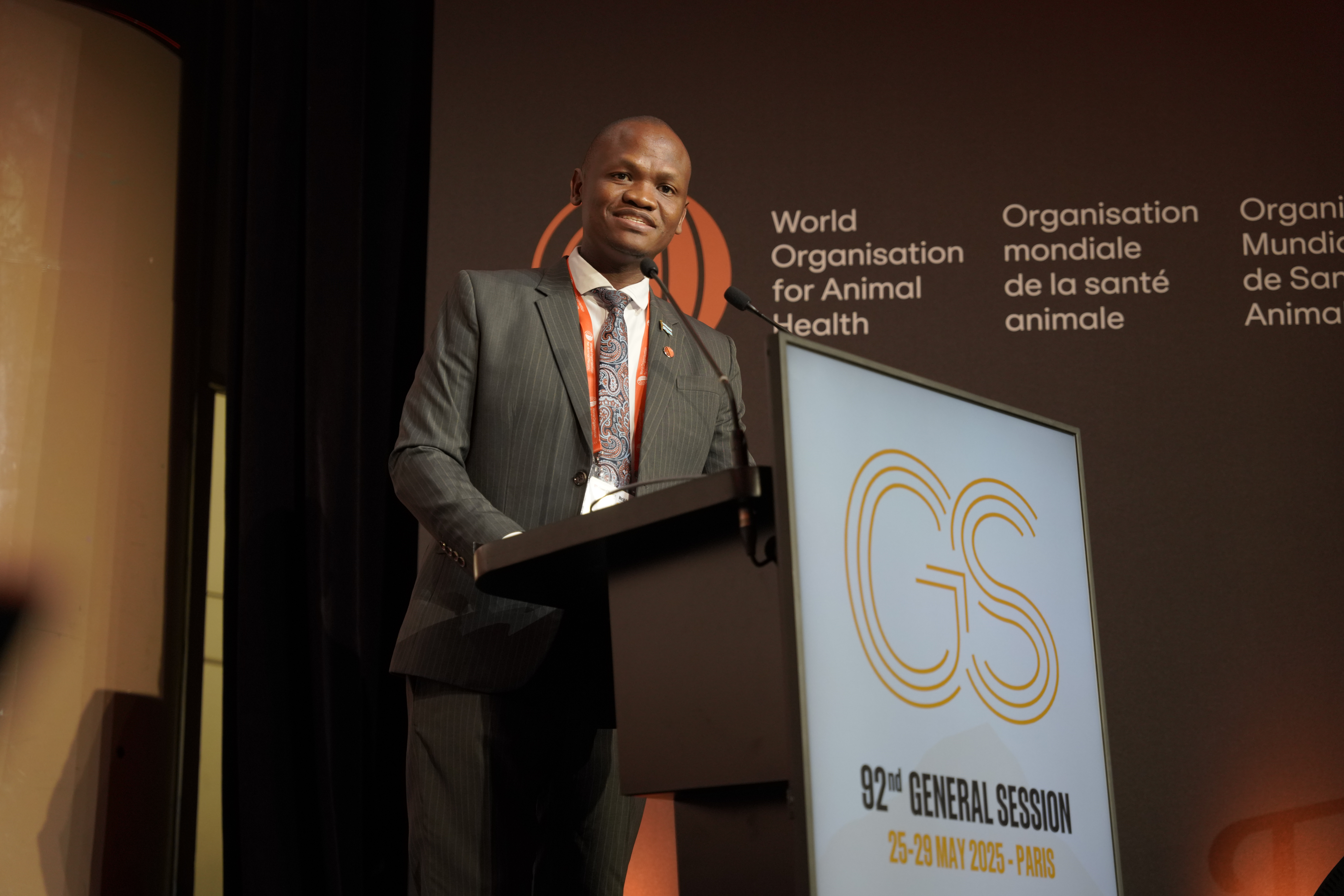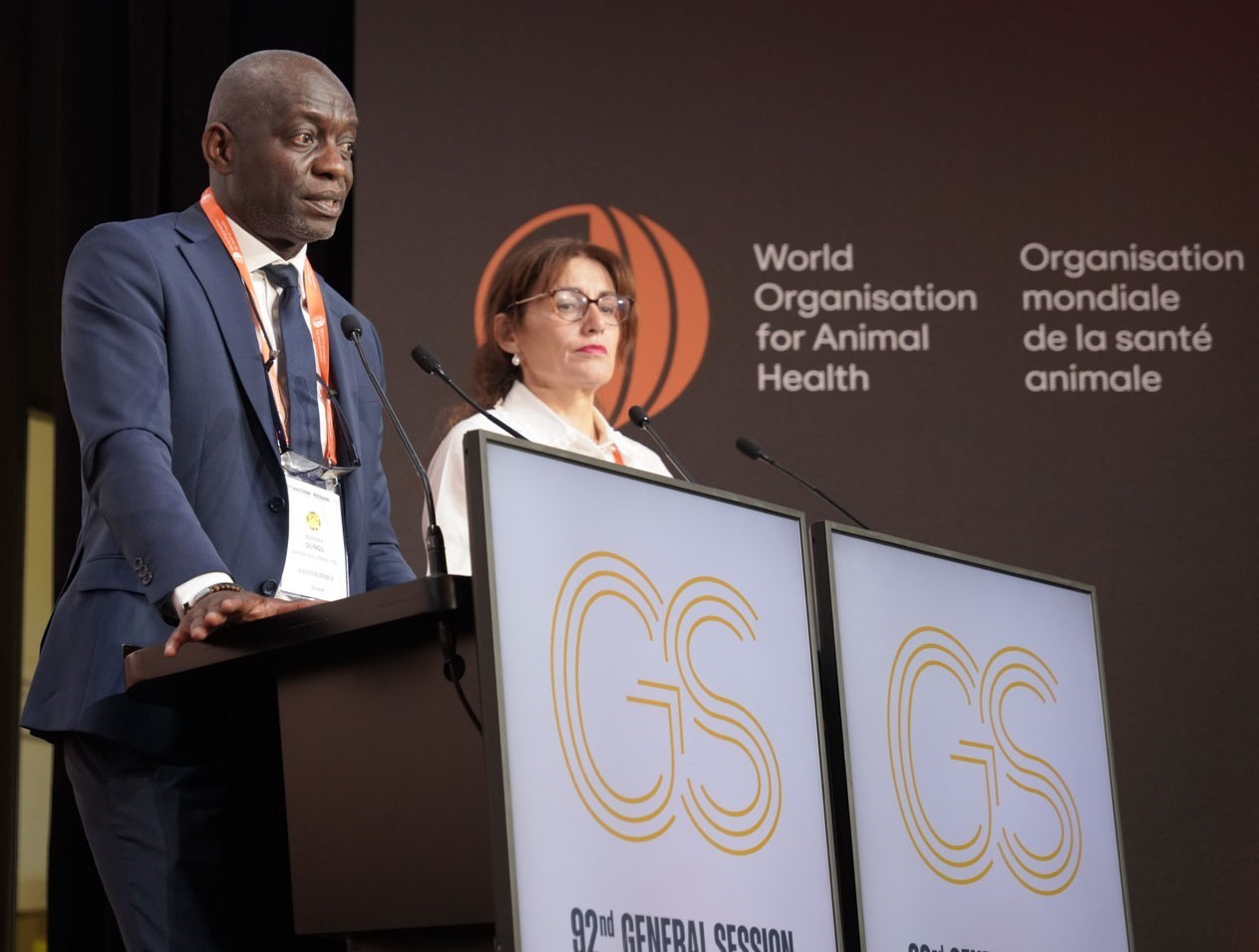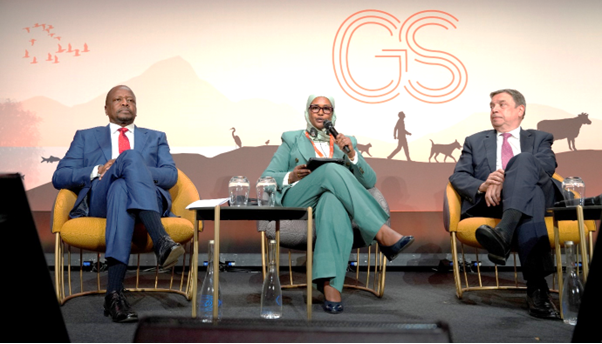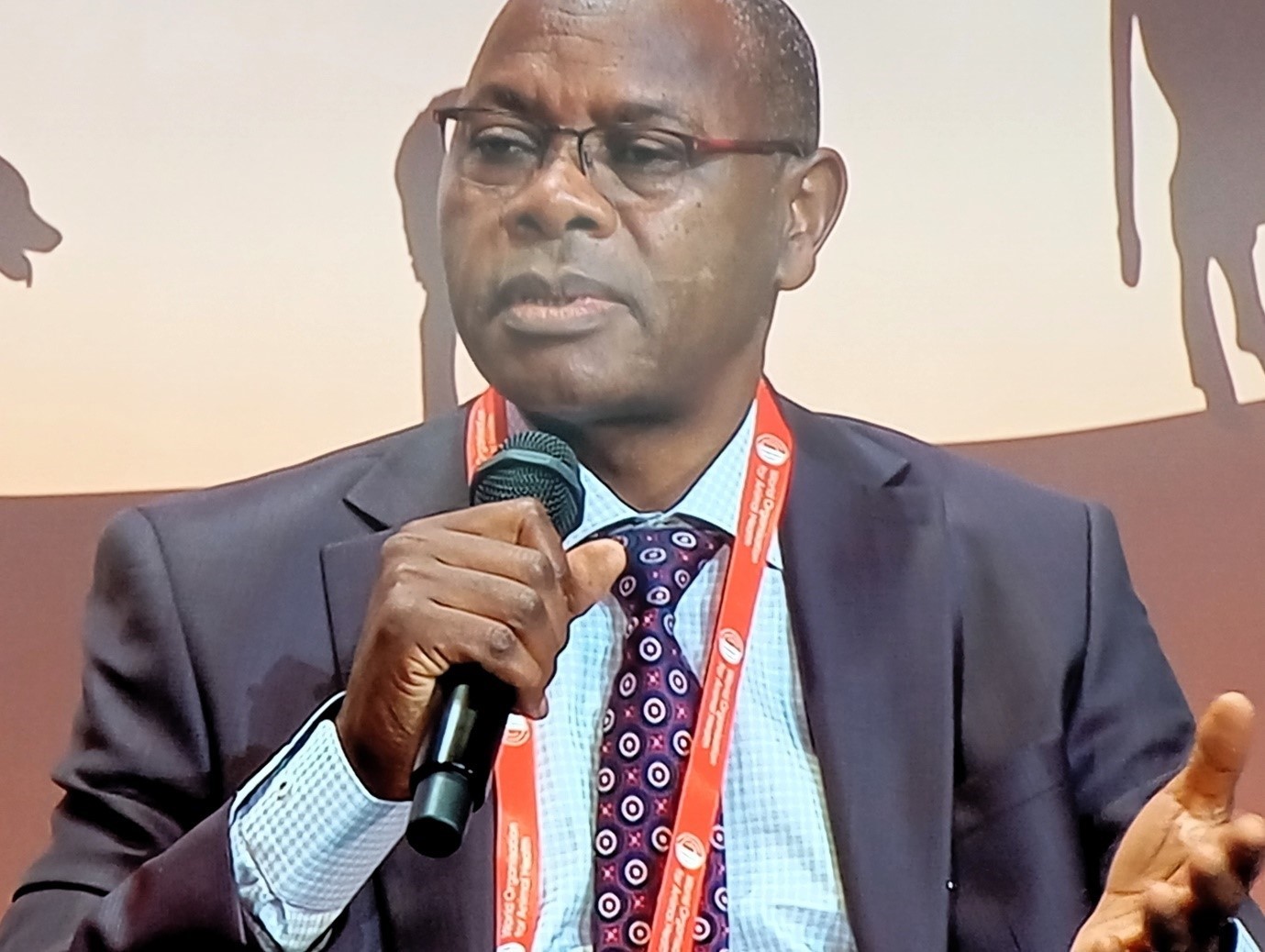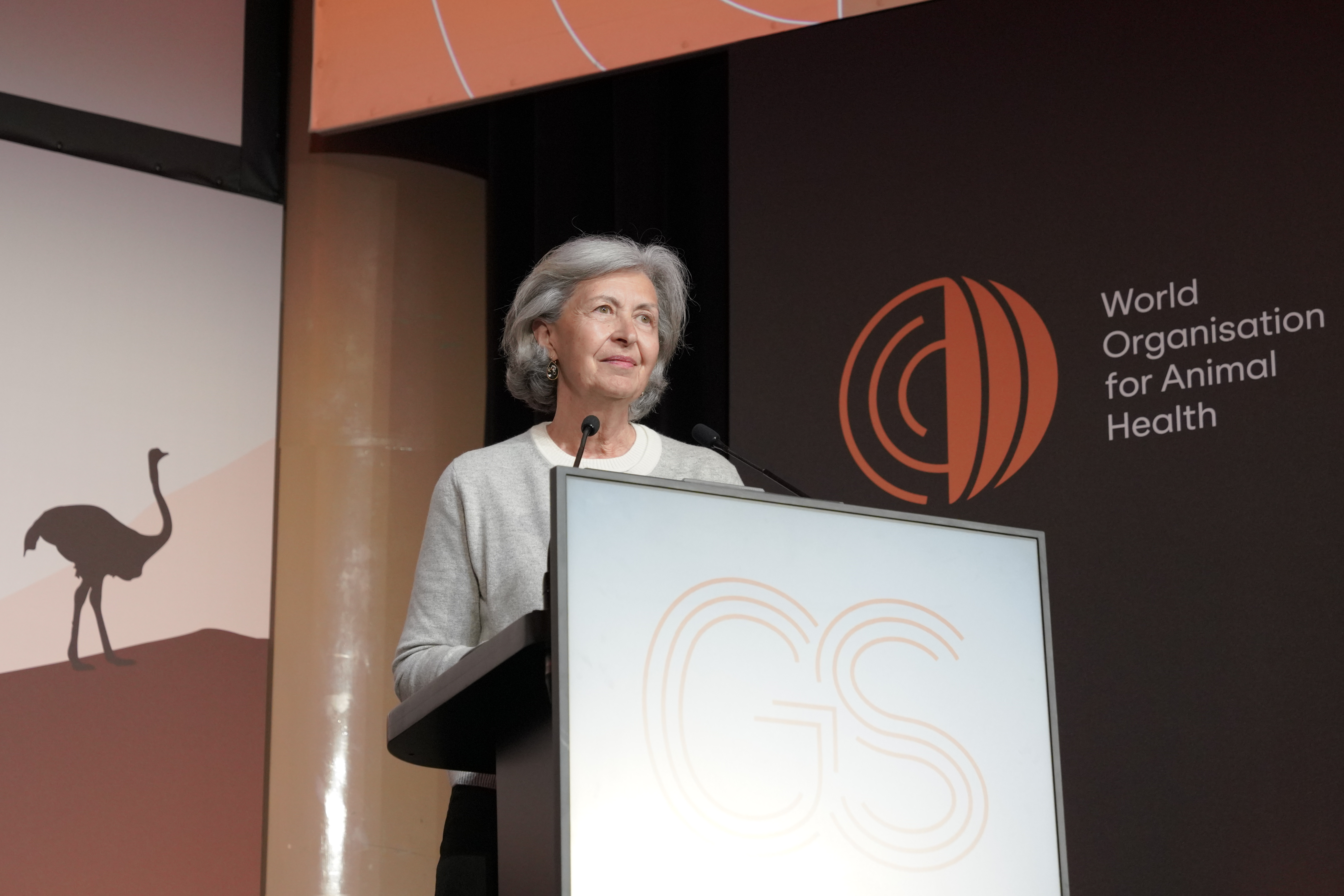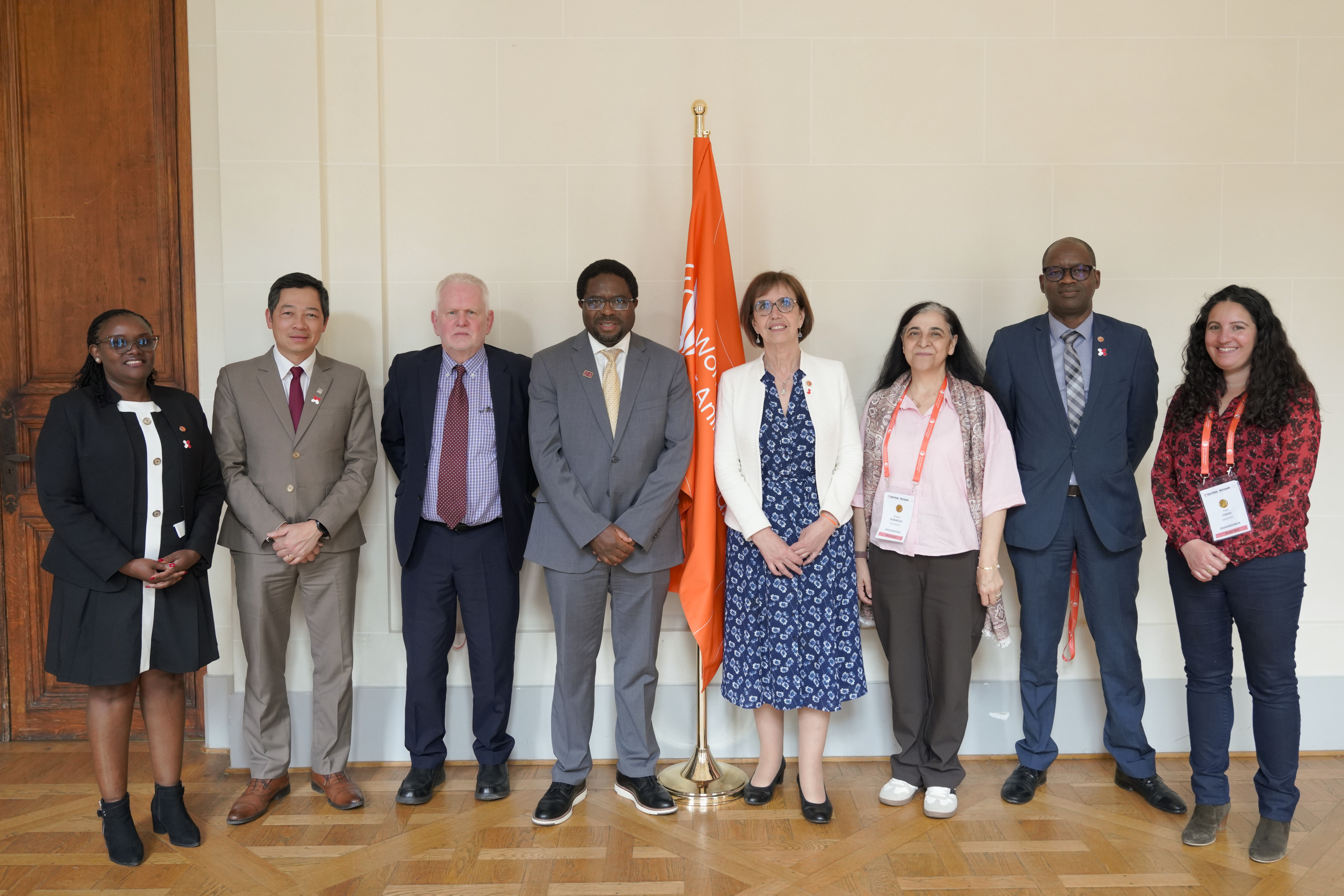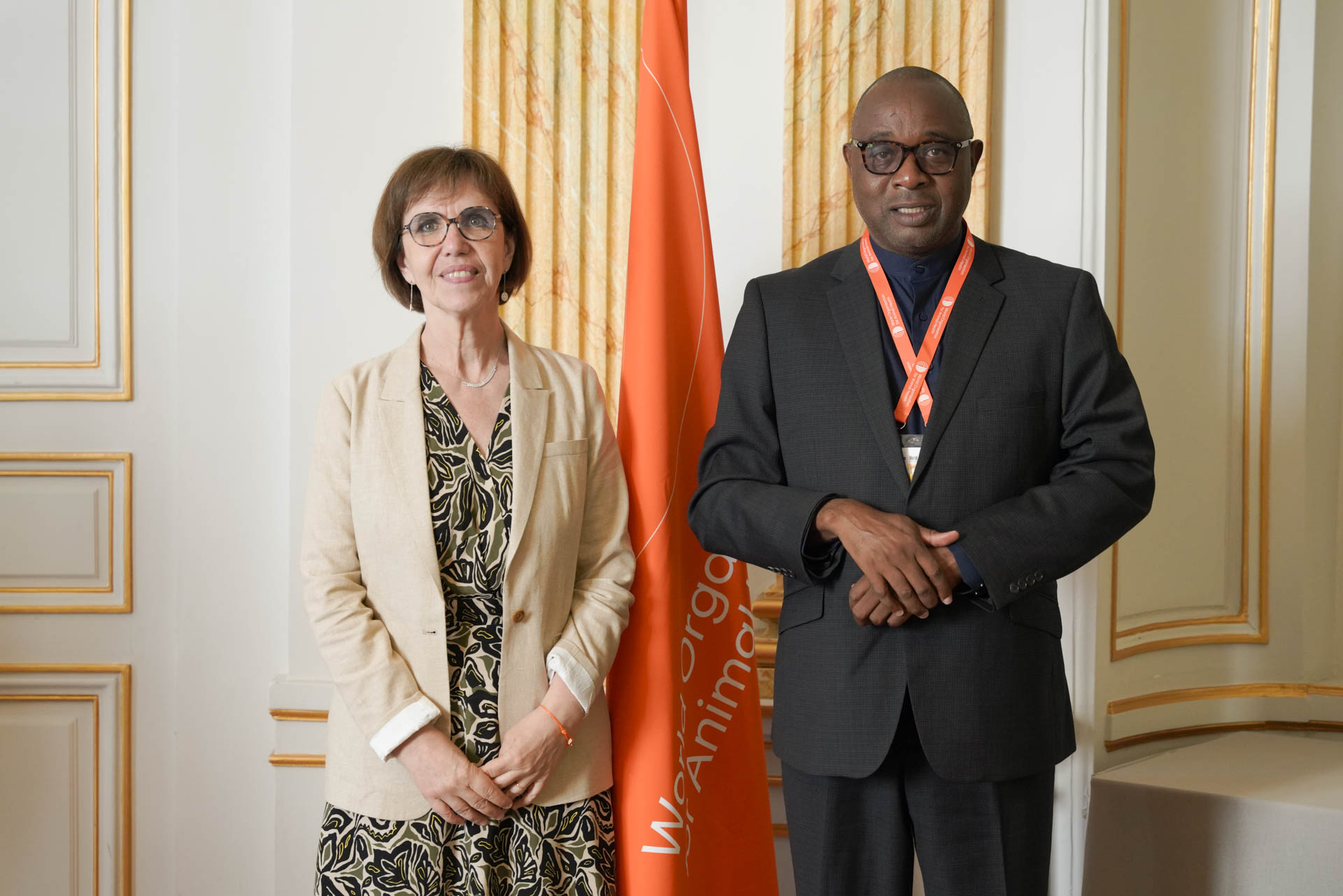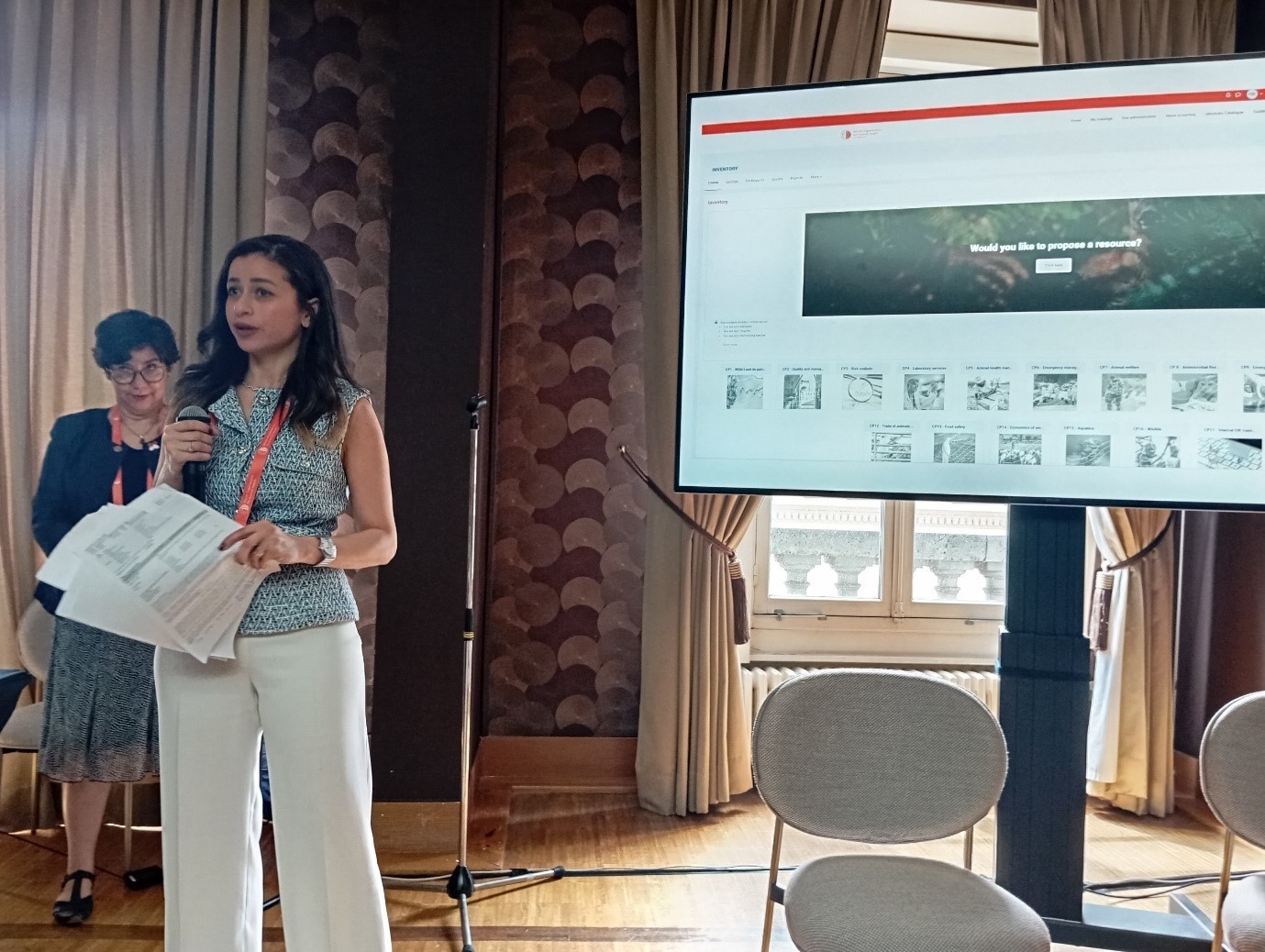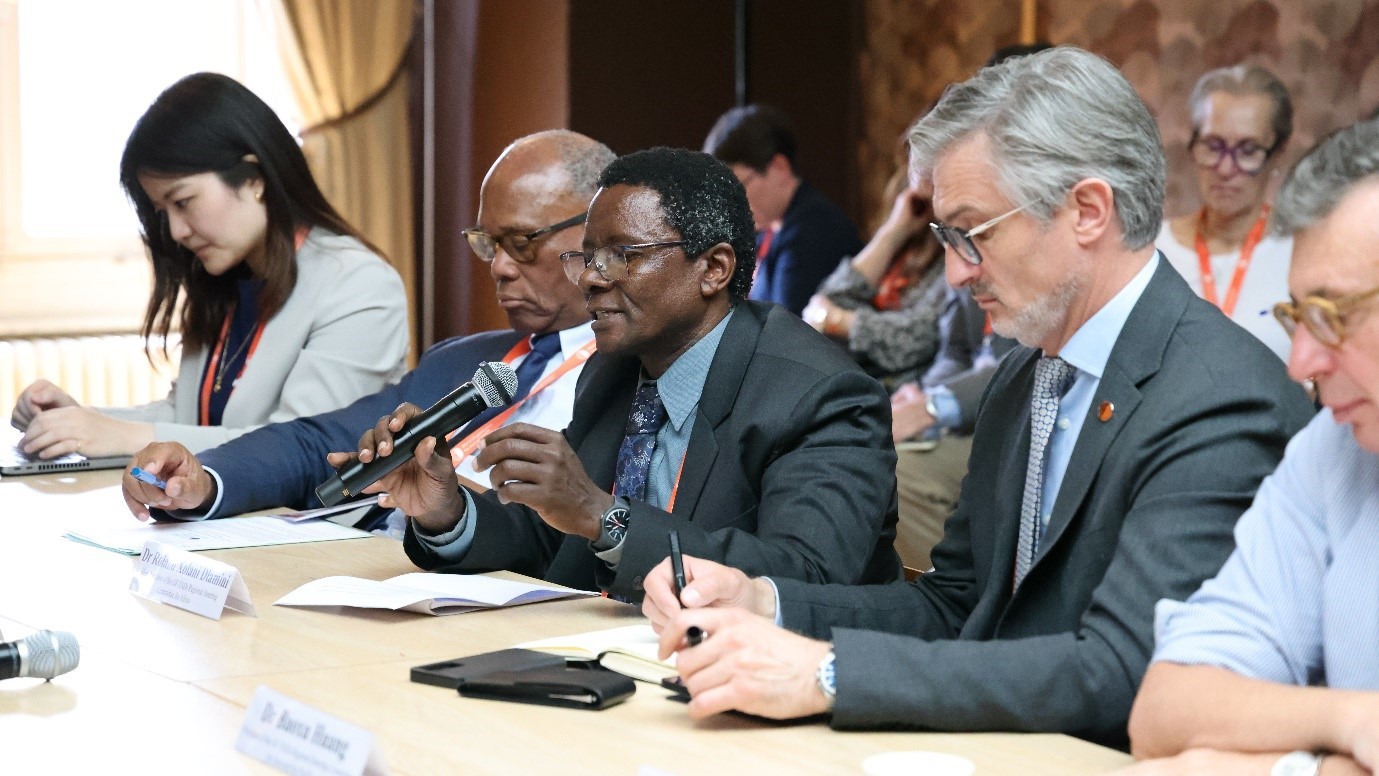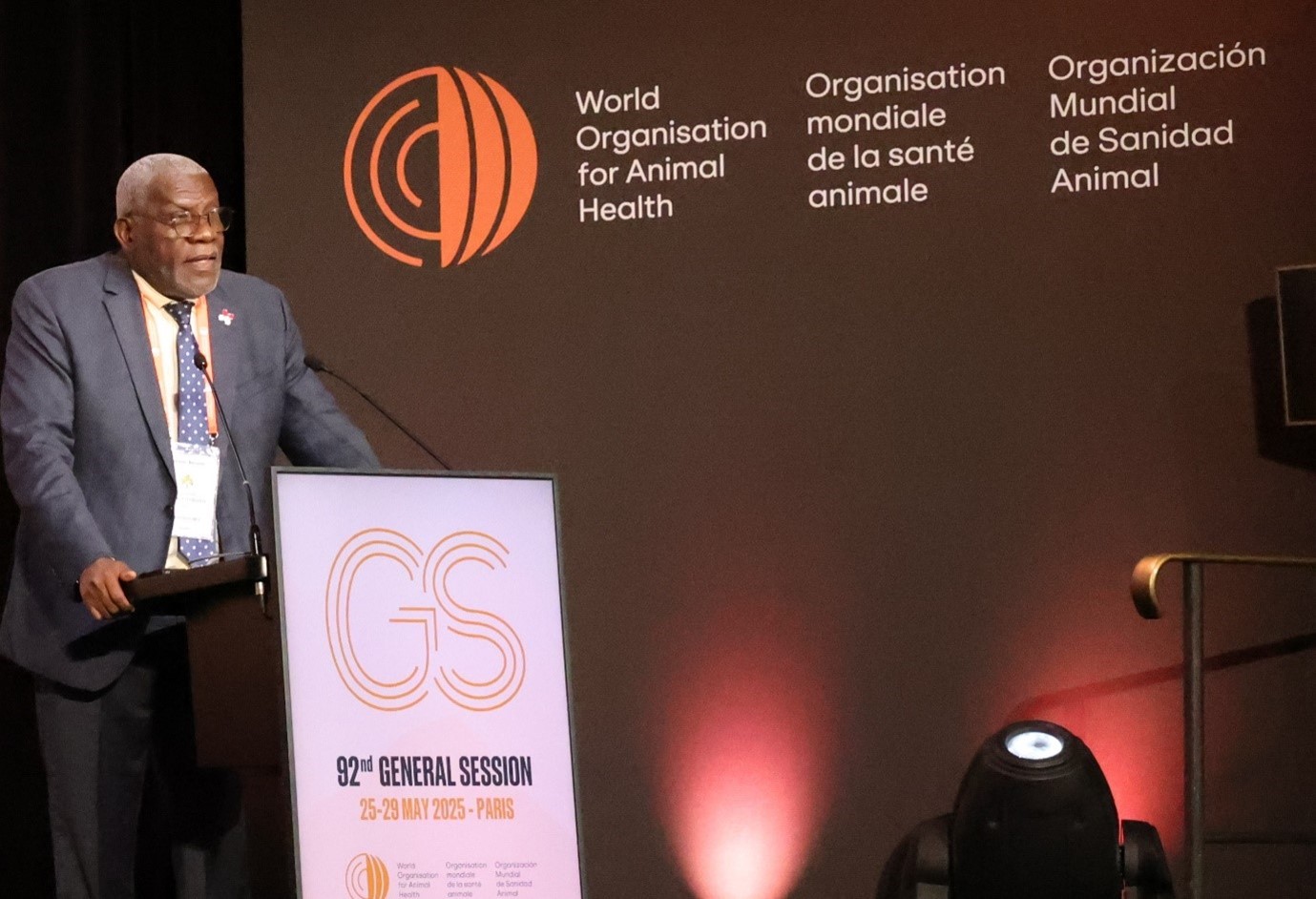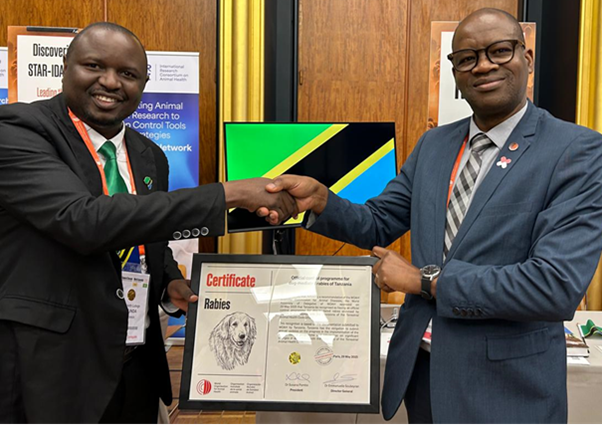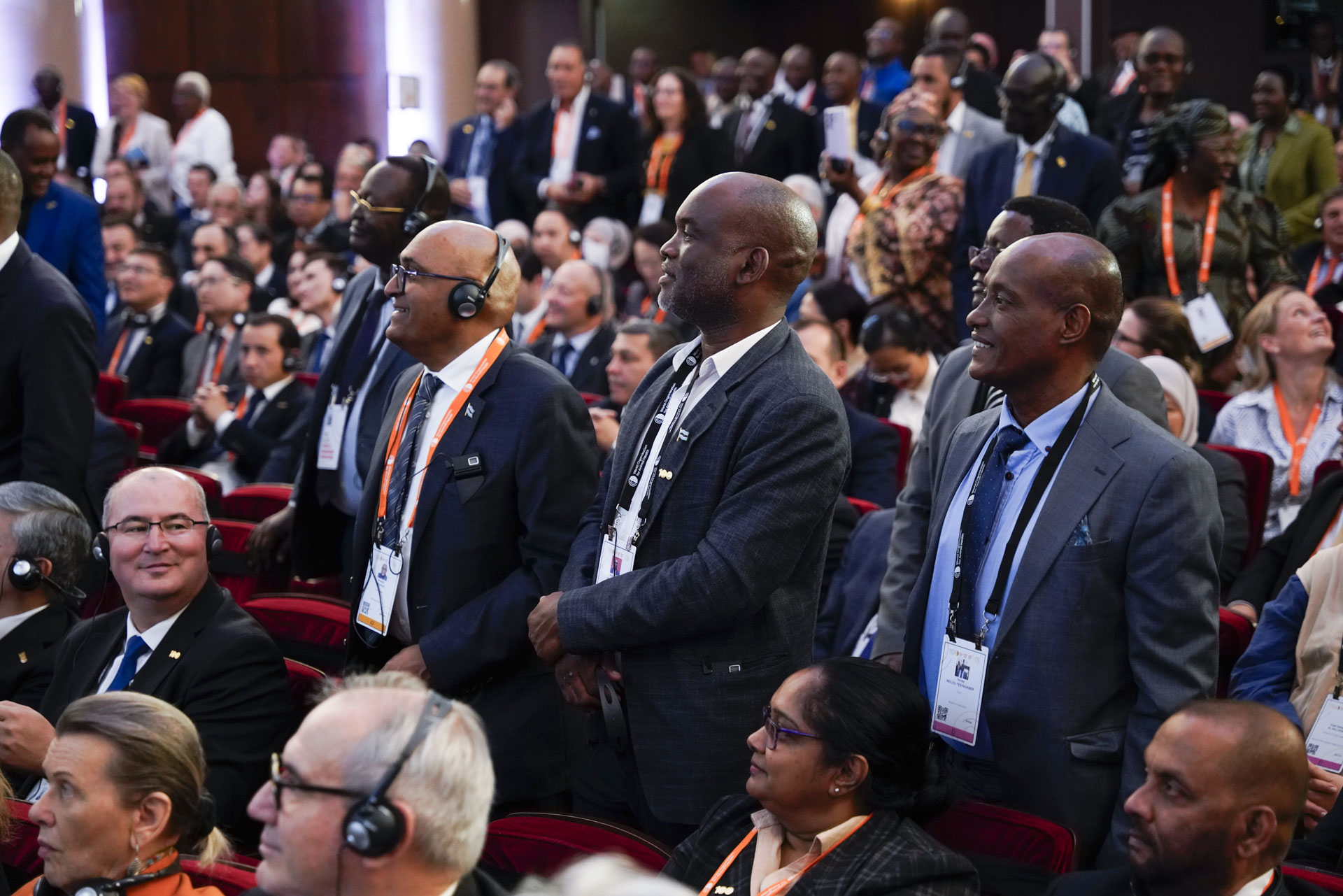
The inaugural ceremony of the 92nd General Session of the World Organisation for Animal Health was held on 25 May 2025 in Room 269 of the Maison de la Chimie in Paris. The event was marked by a number of high-level speeches, including those by the President of WOAH, Dr Susana Pombo, the Director General, Dr Emmanuelle Soubeyran and representatives of partner institutions and government authorities.
In her speech, Dr. Susana Pombo, Delegate for Portugal and President of the WOAH World Assembly of Delegates, expressed her honour and pride at chairing her first General Session, following her election in May 2024. She paid tribute to her predecessors and highlighted the major challenges facing animal health. She called for greater cooperation to promote animal health, animal welfare and public health. She also referred to the work in progress on the review of the governance of the Organisation and the development of the 8th Strategic Plan, two essential tools for strong and effective Veterinary Services. She encouraged all the Delegates to persevere in their efforts, reminding them that WOAH’s actions must be based on rigorous scientific foundations.
On her part Dr Emmanuelle Soubeyran, Director General of WOAH, welcomed all the participants and praised the strong commitment of the authorities and partners. She expressed her gratitude to the Member countries, territories (Members) and partners for their efforts to promote animal health and welfare. She reaffirmed WOAH’s commitment to advocate for funding and highlighted the central theme of this 92nd Session: ‘Vaccines and vaccination’. She renewed her commitment to supporting the Veterinary Services of Members, working with them and for them, in order to strengthen the visibility of the Organisation. Her speech highlighted the challenges posed by the emergence and re-emergence of animal diseases, as well as antimicrobial resistance (AMR), in a complex geopolitical context.
The representatives of government authorities and partner institutions unanimously welcomed the central role of WOAH in securing trade in animals and animal products. They called for closer collaboration between institutions and between member countries to guarantee the effectiveness of actions to combat animal diseases.
Dr. Susana Pombo, President of the WOAH World Assembly and WOAH Delegate of Portugal.
H.E. Mr. Edwin Dikoloti, Assistant Minister of Lands and Agriculture, Republic of Botswana. Picture © M. Tric (woah) 2025.
H.E. Mr. Edwin Dikoloti, Assistant Minister of Lands and Agriculture, Republic of Botswana. Picture © M. Tric (woah) 2025.
Ministers in charge of livestock from several countries were invited to this session and took the floor. These included the Republic of Botswana, H.E. Mr. Edwin Dikoloti, Assistant Minister of Lands and Agriculture and the Kingdom of Morocco, H.E. Mr. Ahmed El-Bouadi, Minister of Agriculture, Marine Fisheries, Rural Development and Water and Forests.
The newly appointed African Union Commissioner for Agriculture, Rural Development, Blue Economy and Sustainable Environment (ARBE), H.E. Mr. Moses Vilakati (Eswatini) also reaffirmed his commitment to working closely with WOAH to address regional and global health challenges.
Finally, the representatives of the Food and Agriculture Organization of the United Nations (FAO) and the United Nations Environment Programme (UNEP) thanked WOAH for its invitation and stressed the importance of a coordinated approach within the framework of the ‘One Health’ initiative, in order to tackle global health challenges in an integrated manner.
As part of the 92nd General Session, WOAH hosted an
Organised in three consecutive sessions, over two days, the objective of the Animal Health Forum was to create a platform for dialogue on the barriers that are currently impeding the development and use of vaccines in disease prevention and control strategies, and to establish a 2 – 3-year roadmap with concrete actions. The technical session was prepared and moderated by consultants Dr Baptiste Dungu and Dr Meritxell Donadeu. The detailed technical report is available here.
WOAH Technical Rapporteurs Dr Baptiste Dungu and Dr Meritxell Donadeu. Picture © M. Tric (woah) 2025 IIIII Rapporteurs techniques de l'OMSA, le Dr Baptiste Dungu et la Dre Meritxell Donadeu. Photo © M. Tric (omsa) 2025
Fltr : H.E. Sen. Mutahi Kagwe, Cabinet Secretary, Ministry of Agriculture and Livestock Development – Kenya, Dr. Huyam Salih, Director of AU-IBAR, and H.E. Don Luis Planas Puchades, Minister of Agriculture, Fisheries and Food – Spain. Picture © M. Tric (woah) 2025
Fltr : H.E. Sen. Mutahi Kagwe, Cabinet Secretary, Ministry of Agriculture and Livestock Development – Kenya, Dr. Huyam Salih, Director of AU-IBAR, and H.E. Don Luis Planas Puchades, Minister of Agriculture, Fisheries and Food – Spain. Picture © M. Tric (woah) 2025.
A panel discussion on vaccination decisions was held, focusing on the desired effects and undesired consequences of vaccines. Panellists included H.E. Don Luis Planas Puchades, Minister of Agriculture, Fisheries and Food – Spain, Dr. Huyam Salih, Director of AU-IBAR – African Union, H.E. Sen. Mutahi Kagwe, Cabinet Secretary, Ministry of Agriculture and Livestock Development – Kenya and H.E. Mr. Sidi Tiémoko Touré, Minister of Animal and Fisheries Resources (Ministre des Ressources Animales et Halieutiques) – Cote d’Ivoire.
The discussion highlighted the importance of vaccines in protecting the livestock industry from disease outbreaks and preventing AMR. However, it also highlighted the need for capacity building, human resources, cold chain maintenance, veterinary infrastructures, and Public-Private Partnerships (PPP) for disease prevention and control. Investment strategies for producing quality vaccines were also discussed.
The high-level panel also discussed the importance of time in vaccine availability and access, highlighting the need for investment in research and development, access to the market at affordable rates, international cooperation, and science-based policymaking. The discussion also touched on the need for strengthening research and policymaking, and the role of countries in strengthening WOAH. The panel concluded by emphasising the importance of communication with trading partners to avoid trade barriers following vaccination.
In a session (2) on vaccine availability and access – “time is of the essence”, panellists discussed the challenges of insufficient funding for research and development being a major obstacle to vaccine availability, as exemplified by a MentiMeter™ poll among participants. The panellists were H.E. Mr. El Moctar Gaguih Ebeyite, Minister of Livestock (Ministre de l’Elevage) – Mauritania, Dr Marc Prikazsky, CEVA Chief Executive Officer (CEO), Dr Dónal Sammin, Executive Secretary of EuFMD, and Mr. Derrick Sim, Managing Director – Vaccines Market and Health Security, GAVI – The Vaccine Alliance.
The session was facilitated by Javier Yugueros Marcos, Head of the AMR and Veterinary Products Department – WOAH.
Outcomes of a MentiMeter(TM) poll amongst participants in the plenary hall, and the video room.
Other key points discussed include Target Product Profiles (TPPs), standardised regulations for aquatic animals, the impact of the Nagoya Protocol on sample shipment, vaccine availability and accessibility gaps in rural and urban areas, regulatory affairs, low awareness of diseases and vaccination solutions by farmers, and the long-term nature of vaccine production.
In the subsequent two sessions (under the technical item : Vaccine and Vaccination: “from science to action – reflections for change”), the discussions on vaccines and vaccinations focused on the benefits and costs of vaccination, the decision to vaccinate or not, and the importance of community engagement and awareness education.
In the first of these two sessions (“To vaccinate or not to vaccinate. That is the question”) panellists were Dr. Hendrik-Jan Roest, Deputy CVO – The Netherlands, Dr Allan Azegele, WOAH Delegate – Kenya, Dr. Huang Baoxu, WOAH Delegate – Peoples’ Republic of China and Mr. Julian Madeley, Director General, World Egg Organisation.
Dr. Allan Azegele, WOAH Delegate of Kenya, commenting on the misinformation and disinformation campaign waged after the launch of Kenya’s national livestock vaccination drive targeting FMD and PPR [ screen capture ].
Dr. Allan Azegele, WOAH Delegate of Kenya, commenting on the misinformation and disinformation campaign waged after the launch of Kenya’s national livestock vaccination drive targeting FMD and PPR [ screen capture ].
In the second session (“Bridging gaps to enhance vaccine availability”) panellists were Prof. Ann Cullinane, WOAH Biological Standards Commission, Dr. Bernadette Abela, Lead, Neglected Zoonotic Diseases, WHO, Dr. Carlos Orellana Vaquero, WOAH Delegate – Chile, Dr. Donald King, Member of the WOAH Biological Standards Commission and Head of the WRL for FMD at The Pirbright Institute – UK, and Dr. Carolin Schumacher, CEO of GALVmed.
The various panellists emphasised the need for standardised regulations on the safety and efficacy of vaccines for aquatic animals, the impact of the Nagoya Protocol on research and development, and the need for vaccine availability and accessibility gaps in low-middle income countries (LMICs). They also highlight the need for a standardised approach to vaccine development, the need for a better understanding of diseases and vaccination solutions, and the long-term nature of research and development. The speakers (again) emphasised the need for effective communication with trading partners to avoid trade barriers and ensure the availability of vaccines.
Dr. Carlos Orellana Vaquero, Vice President of the Regional Commission for the Americas, WOAH Delegate from Chile.
In the next session the discussion focused on “overcoming barriers to timely access to quality vaccines” with a strong focus on developing countries. Panellists were Dr. Assiongbon Teko-Agbo, WOAH Collaborating Centre for the Control of veterinary drugs in Western and Central Africa (EISMV, Dakar) – Senegal, Dr. Alisdair King, Executive Director Transboundary Diseases, Merck, Ms. Alka Upadhyaya, WOAH Delegate – India, and Dr. Charles Bodjo, Acting Director, AU-PANVAC – African Union. Key points included a standardised system for registering products, quality assurance to prevent counterfeits, and the use of vaccine banks for quality assurance. Emergency vaccination provisions were also discussed, with a focus on affordability for farmers. Note that in Africa, AU PANVAC is mandated for vaccine registration and certification processes.
In the penultimate session (“Strategic Vaccination: Paving the path to a healthier future”) the discussion emphasised the importance of disease-specific vaccination strategies, financial and political support, smart monitoring, pharmacovigilance, social research, and communication to prevent vaccination hesitancy and misinformation. Panellists included -amongst others- the Delegates on Japan, Dr. Masatsugu Okita, and of France, Dr. Marie-Christine Le Gal, as well Mr. Phil Hadley, Secretary General of the International Meat Secretariat (IMS).
The Animal Health Forum 2025 concluded with a discussion on Trade and societal acceptance: “the ‘x’ and ‘y’ on the vaccination equation”. The panellists were Dr. Gaston Funes (Vice-President of the WOAH Terrestrial Code Commission), Mr. Rolando Alcala (WTO), Mr. Felix Metzger (President, IVSA), and Dr. Emmanuelle Soubeyran, WOAH Director General. The session was facilitated by Dr. Mary van Andel (WOAH Delegate of New Zealand) and the discussions focused on the role of WOAH in the WTO and students’ perspectives (International Veterinary Students’ Association, ISVA) on vaccination. The goal – all agreed – is to ensure that vaccines are accessible and affordable for farmers to take up and contribute to a healthier future.
The General Session was attended by the following 33 (out of 54) African Members (countries and territories, either represented by the Delegate or the designated Alternate Delegate, AD) :
Recipient of the WOAH Gold Medal, Dr Monique Eloit, immediate past Director General of WOAH. Picture © Maurine Tric (woah) 2025.
Recipient of the WOAH Gold Medal, Dr Monique Eloit, immediate past Director General of WOAH. Picture © M. Tric (woah) 2025.
The first day was concluded by the WOAH President, Dr Susana Pombo, and WOAH’s Director General, Dr Emmanuelle Soubeyran, who paid tribute to four personalities for their outstanding contributions to animal health, animal welfare and veterinary public health.
The Gold Medal was awarded to Dr Monique Eloit, former Director General of WOAH, in recognition of her exemplary leadership, her decisive role in strengthening the global influence of the Organisation, the implementation of the 7ᵉ Strategic Plan, her commitment against antimicrobial resistance and the development of animal disease surveillance systems.
Prof. Dr. Justin Akakpo (Togo), recipient of the 2025 WOAH meritorious award (between Drs Pombo, right and Soubeyran, left). Picture © Maurine Tric (woah) 2025.
Prof. Dr. Justin Akakpo (Togo), recipient of the 2025 WOAH meritorious award (between Drs Pombo, right and Soubeyran, left). Picture © Maurine Tric (woah) 2025.
Professor Ayayi Justin Ayih-Akakpo, from Togo, was honoured for his research into rabies and brucellosis, and for his major contribution to the training of several generations of African veterinarians as lecturer at the Inter-State School of Veterinary Medicine and Sciences (EISMV, Dakar, Senegal).
Other recipients of the meritorious award were Dr Jamil Gomes de Souza, from Brazil and Dr Bakhoromjoni Makobilov, from Uzbekistan.
Members of the Bureau of the Regional Commission for Africa, African WOAH Council Members and the WOAH Regional Representative. Fltr : Drs Mbargou Lô, Karim Tounkara, Honoré N’Lemba and Roland Dlamini. Picture © P. Bastiaensen (woah) 2025.
Members of the Bureau of the Regional Commission for Africa, African WOAH Council Members and the WOAH Regional Representative. Fltr : Drs Mbargou Lô, Karim Tounkara, Honoré N’Lemba and Roland Dlamini.
Picture © P. Bastiaensen (woah) 2025.
For the second year in a row, the meeting of the Regional Commission for Africa took place in two distinct sessions, a first online session of around three hours took place on Thursday afternoon, 8 May, whilst a second session took place, as a face-to-face meeting, on Sunday morning of 25 May, for around two hours. The Paris meeting brought together 31 Commission members from the following countries: Algeria, Angola, Benin, Botswana, Cabo Verde, Chad, Republic of the Congo, Democratic Republic of the Congo, Côte d’Ivoire, Djibouti, Eritrea, Eswatini, Gambia, Guinea, Kenya, Liberia, Mali, Mauritania, Morocco, Mozambique, Namibia, Rwanda, Senegal, Somalia , South Africa, South Sudan, Sudan, Tanzania, Togo, Uganda, and Zimbabwe. Numerous international and regional partner organisations were also present.
The meeting was chaired by Dr Honoré Robert N’lemba Mabela, President of the Regional Commission and WOAH Delegate of the Democratic Republic of Congo, accompanied by Dr Karim Tounkara, WOAH Regional Representative for Africa.
Dr Botlhe Michael Modisane (WOAH Delegate, South Africa) presented a summary of the WOAH Governance Review Committee (GRC) discussions and requested Members’ support to consult Delegates on their intentions and gather their feedback to finalize the Africa proposal. Several aspects were discussed, including gender balance, mandates, etc. This presentation was followed by other updates on the overview of the regional quadripartite activities, emphasizing the critical importance of collaboration at national, regional, and global levels (Dr Lillian Wambua, WOAH Regional Programme Officer One Health), Kenya’s support of the candidacy of the International Livestock Research Institute (ILRI) to become a WOAH One Health Collaborating Centre (Dr Allan Azegele, WOAH Delegate from Kenya). The said proposal was unanimously approved by the Regional Commission for Africa and was submitted to the World Assembly for endorsement.
There was also a report by Dr Barbara Alessandrini (Head of Department, WOAH Capacity-building Department) on the Africa Continental Conference on Veterinary Workforce Development, held in Nairobi in November 2024, as well as a report by Dr Rose Ademun-Okurut (WOAH Delegate, Uganda and Vice-President of the Regional Commission) on the online meeting held on 8 May 2025. In addition, the Commission proposed that Dr Abdou Ceesay (Gambia) replace Dr Columba Vakuuru (Nigeria) as Secretary General of the Bureau, who recently retired. This appointment was submitted for validation at the World Assembly on 29 May 2025.
The reflections on Statutory Contributions by Member Countries allowed several Members to share their good and bad experiences, hoping to learn from each: South Africa, Uganda, Côte d’Ivoire, Senegal, Republic of Congo, Benin, and Rwanda. Dr Roland Dlamini (Eswatini, Council Member) emphasized the need to ensure a quorum at the World Assembly, and this is not possible with numerous Members not being able to vote because of arrears. Also, it is important for the African continent to make its voice heard with any many Members as possible. Again, this is not possible with numerous Members not being able to vote because of arrears.
Welcoming ILRI as a new WOAH Collaborating Centre for One Health. Fltr: Dr Lillian Wambua (WOAH One Health Regional Programme Officer), Dr Hung Nguyen-Viet (ILRI Leader a.i. of the Health Programme), Prof. Andy Peters (ILRI Board), Prof. Appolinaire Djikeng (ILRI Director General), Dr Emmanuelle Soubeyran (WOAH Director General), Dr Chadia Wannous (WOAH One Health Global Coordinator), Dr Néo Mapitse (WOAH Sub-Regional Representative for Eastern Africa) and Yael Farhi (WOAH Advocacy Advisor to the Directorate General). Picture © M. Tric (woah).
Welcoming ILRI as a new WOAH Collaborating Centre for One Health. Fltr: Dr Lillian Wambua (WOAH One Health Regional Programme Officer), Dr Hung Nguyen-Viet (ILRI Leader a.i. of the Health Programme), Prof. Andy Peters (ILRI Board), Prof. Appolinaire Djikeng (ILRI Director General), Dr Emmanuelle Soubeyran (WOAH Director General), Dr Chadia Wannous (WOAH One Health Global Coordinator), Dr Néo Mapitse (WOAH Sub-Regional Representative for Eastern Africa) and Yael Farhi (WOAH Advocacy Advisor to the Directorate General). Picture © M. Tric (woah).
Dr Emmanuelle Soubeyran, Director General (left) and Mr Davis Marapira, Deputy Minister of Lands, Agriculture, Fisheries and Rural Development of Zimbabwe (right). Picture © M. Tric (woah) 2025.
Below : Dr Emmanuelle Soubeyran, Director General (left) and Mr Davis Marapira, Deputy Minister of Lands,
Agriculture, Fisheries and Rural Development of Zimbabwe (right). Picture © M. Tric (woah) 2025.
Panel discussion. Fltr : The WOAH Delegates of India, Ms. Alka Upadhyaya, and Chad, Dr Ghislaine Singambaye, and Dr Ashish Sutar from the WOAH Sub-Regional Representation for South-East Asia. Picture © M. Tric (woah) 2025.
Panel discussion. Fltr : The WOAH Delegates of India, Ms. Alka Upadhyaya, and Chad, Dr Ghislaine Singambaye, and Dr Ashish Sutar from the WOAH Sub-Regional Representation for South-East Asia. Picture © M. Tric (woah) 2025.
The session was introduced by Dr François Caya, WOAH Deputy Director General, presenting the WOAH Training Platform and its numerous online training modules. The (hybrid) meeting, attended by some 80 participants, then covered WOAH’s competency-based training framework, available in three languages and entirely free-of-charge (Hana Abdelsattar and Myriam Carpentier).
The panel discussion that followed was facilitated by the WOAH Delegates of India, Ms. Alka Upadhyaya, and Chad, Dr Ghislaine Singambaye, and Dr Ashish Sutar from the WOAH Sub-Regional Representation for South–East Asia.
Drs. Hana Abdelsattar (front) and Myriam Carpentier (back) of the WOAH Capacity – building Department. Picture © P. Bastiaensen (woah) 2025.
Drs. Hana Abdelsattar (front) and Myriam Carpentier (back) of the WOAH Capacity – building Department. Picture © P. Bastiaensen (woah) 2025.
All panelists stressed the importance of e–learning and in particular the WOAH e-modules as pathways to continuous learning. As explained by Dr Singambaye, the PRAPS project has helped in bring countries to develop (in-house) national training programmes, very often using the WOAH e-module in addition to on-site training.
Ms Silvia D’Albenzio, Training Manager at the IZS (Teramo, Italy), a WOAH Collaborating Centre, focused on the rapidly changing technology environment, presenting challenges, but also opportunities for upscaling and sustaining (affordable) e-learning. Certification is regarded as an important motivator for engaging learners, provided the contents is fit-for-purpose and culturally appropriate. The delegate from Chad, Dr. Ghislaine Singambaye, highlighted that the implementation of national training plans in PRAPS countries would be further enhanced through the e-learning modules offered by WOAH.
The session was opened by Dr Javier Yugueros – Marcos, Head of Department of WOAH’s AMR and Veterinary Products Department, who presented the issue of antimicrobial resistance (AMR), highlighting its socio-economic impact and its relationship with human-animal interactions, with a particular focus on companion animals. Experts from the World Small Animal Veterinary Association (WSAVA) stressed the importance of vaccination in companion animals, particularly cats and dogs. Vaccination helps to protect animals, which indirectly reduces the need for antibiotics. Speakers highlighted the need for good governance of medicines, both by vets and pet owners. The management of residual stocks, the avoidance of reuse of unprescribed antibiotics, and the proper use of antimicrobials were widely debated. It was also underscored that a solid legal framework is essential to effectively address this issue. There was also a call to action for the proactive inclusion of AMR–in–companion–animals in national action plans (NAPs) and AMR surveillance programmes. There’s a pressing need to improve access to vaccines and antimicrobials for companion animals in low-income countries. Finally, the availability of data, information sharing and awareness-raising at all levels – political decision-makers, veterinarians, animal owners and the general public – were identified as key elements in the fight against AMR.
Dr Roland Dlamini, WOAH Delegate from Eswatini, WOAH Council Member and Vice-President of the RSC of the GF-TADs for Africa, reporting to the GCC. Picture © Kevin Tschierse (woah) 2025.
The meeting was chaired by Dr Conrad Estrada (USDA), President of the RSC for the Americas and Dr Gregorio Torres, Head of Department of the WOAH Science Department, acknowledging his counterpart at FAO, Dr Andriy Rostalnyy of the Global Working Group. Dr Charmaine Chng provided a brief overview of the ASF Global Initiative (GI) and the activities of – among others – the Africa Region ASF SGE. Vice-President of the RSC of the GF-TADs Dr Roland Dlamini (WOAH Delegate of Eswatini), on behalf of the President, Dr Huyam Salih (AU) reported on the Continental Strategy for ASF in Africa (AU) and the ongoing work programme of the SGE for ASF in Africa, based on topical issues identified by the region; the SGE has since covered the topics on: Value Chains, Biosecurity, Surveillance and Outbreak Management. Other topics in the pipeline are socioeconomics, policy, transparency and cross-border issues.
Dr Roland Dlamini, WOAH Delegate from Eswatini, WOAH Council Member and Vice-President of the RSC of the GF-TADs for Africa, reporting to the GCC. Picture © Kevin Tschierse (woah) 2025.
The President of the RSC of the Europe GF-TADs, Dr. Bernard Van Goethem (EU), pointed out that as far as Europe is concerned, they don’t see value in the continuation of the SGE for Europe, as all the issues listed at the time have been dealt with, but would continue to support other regions, with their acquired experiences and available experts.
When asked what are the priorities that one would like the GF-TADs ASF WG to work on in the coming year, the Africa region suggested to advocate for more capacity building, investments and support national control programmes, including improving risk communication and community engagement, as this will lead to more meaningful outcomes. It’s crucial that the population understands the risk factors, prevailing gaps and how they can contribute to preparedness and response. Africa has a regional (continental) ASF Strategy validated by the WOAH Delegates and through the existing mechanism of the SGE, supports advocacy for ASF control and investment, sharing technical scientific information, fostering solidarity and cooperation among countries. The Regional Strategy promotes gradual and steady progress towards the four main objectives of understanding epidemiology, institutional capacity, prevention and control and sustainable pig production building on three fundamental principles, i.e. evidence-based action, value chain approach and participatory engagement. Each Member needs to develop locally adapted national plans aligned with the regional strategy, especially those still free from the disease to enhance their early warning systems and preparedness.
Dr Gregorio Torres addressed the issue of focusing on more than just ASF in the next Global Initiative. This doesn’t seem to be an option that many regions would support, given the specificities of ASF and the challenges brought on by the (absence) of vaccination. Dr Dlamini, likewise, argued that rather than going broader, the GI should go deeper and try to reach out to lower levels of producers and stakeholders (including consumers) at country level.
The ASF-WG (represented by Dr Gregorio Torres and Andriy Rozstalnyy) summarized the discussion with key points as follows:
In conclusion, the GCC meeting agreed that the next GI should not be all that “global” but rather emphasise regional and national best practices, whether aiming for control or eradication (as in Europe) or progressive control and business continuity (In Africa and Asia). An advanced draft of the next GI should be ready by November 2025.
Following the successful eradication of Rinderpest in 2011, the global veterinary community identified PPR as the next priority for eradication alongside dog-mediated rabies. In 2015, the Food and Agriculture Organisation of the United Nations (FAO) and WOAH (then OIE) launched the PPR Global Control and Eradication Strategy (PPR GCES) with the ambitious goal of eradicating the disease by 2030. Overcoming barriers in the eradication process is essential to achieving PPR eradication, safeguarding livelihoods, and strengthening food security for some of the world’s most vulnerable populations. Reflecting on ten years of implementation, the meeting at the sidelines of the GS-92 provided highlights of the status of PPR disease infection, national prevention and control efforts, guidance on priority technical areas and gaps for prioritization for investment by stakeholders and additional resource mobilization.
The opening remarks provided by Dr Emmanuelle Soubeyran, the Director General of WOAH and Dr. Thanawat Tiensin, the Assistant Director General of FAO stated that PPR is a severe disease that causes economic losses, estimated at USD 2.1 billion annually. Beyond its economic impact, this disease is linked to broader global challenges such as food security, gender equity, and improved livelihoods. Eradicating PPR will unlock economic opportunities in national and international trade, contributing to growth and stability. The PPR secretariat in their presentation made by Dr. Viola Chemis (WOAH) and Dr. Felix Njeumi (FAO) provided a global overview of the prevention and control status according to the PPR Monitoring and Assessment Tool (PMAT), the key interventions conducted and regional efforts in coordination and harmonisation of eradication efforts. The PPR Advisory Committee represented by the incoming Chair, Dr. Adama Diallo (PPR Vaccination Expert), stated that PPR has been well controlled in some countries, with 57 countries and one zone recognised by WOAH as free from PPR. Nonetheless, he reminded the meeting, in order to eradicate PPR, technical efforts should be appropriately directed following a well-designed strategy, supported by good infrastructure, societal and political commitments. He called for PPR eradication to be taken forward in considered an international public good.
The discussion was further taken forward in two panel sessions, focusing on political commitment and resource mobilisation. Representing the voices of farmers as President of the International Sheep Veterinary Association and board member of the International Goat Association, Dr. Paula Menzies, stated that to achieve the global goal of PPR eradication, we must recognise, support, and elevate the voices of nomadic (pastoralist) women and youth. Dr. Amarsanaa, specified these category of livestock stakeholders are not merely beneficiaries of interventions. They are essential partners and leaders whose knowledge, care, and perspectives are vital to success. Delegates in the Panels were Dr. Abderrahman El-Abrak (Morocco), Dr. Iqbal Qtananni (Jordan), Dr. Baoxu Huang (China) and Dr. Rama Sinha (representing the Government of India). They collectively elaborated the losses that come with dealing with infectious diseases such as PPR. With clarity, they mentioned that eradication makes economic sense, they are ready to cooperate with other WOAH members, support partnerships with private sector as they foresee the benefit that investment is expected to be recovered within 5 years.
WOAH Delegates and Participants of the 92nd General Session of WOAH keenly follow discussions at the PPR side event. Picture © V. Chemis (woah) 2025
On behalf of Africa as the President of the Regional Steering Committee of the GF-TADs for Africa and Director of AU-IBAR, Dr. Huyam Salih elaborated on the AU Pan-African Strategy, mobilisation efforts to ensure its prioritisation in the CAADP Declaration, commitment by Members, the support by the European Union to the tune of EUR 98 million to be committed in phases (phase I already started, to be followed by a blended financing mechanism with the aim to attract additional needed investment). She reiterated the unavoidable condition that funding needs to be available to complete the eradication, hence the need for collaboration and resource commitments, including national resources.
In conclusion, the priority to eradicate PPR remains a common global agenda with necessary political and financial commitments required. All stakeholders were urged to reaffirm their commitment to eradication of PPR and work collaboratively. The International Organisations led by FAO and WOAH remain committed to support Members’ priorities ensuring visibility and advocacy based on evidence.
WOAH Delegates and Participants of the 92nd General Session of WOAH keenly follow discussions at the PPR side event. Picture © V. Chemis (woah) 2025
Fltr : Dr. Amarsanaa Lkhagvasuren (Expert representing Mongolia), Dr. Bernard Van Goethem, President of the RSC of the GF-TADs for Europe (European Commission, DG SANTE), Dr Laure Weber-Vintzel, Senior Livestock Specialist, World Bank, Dr. Adama Diallo, Chair of the PPR Advisory Committee (AC), Dr Hung Nguyen-Viet, acting Head of the Health Programme (ILRI), Dr Iqbal Qtannani, WOAH Delegate of Jordan, and Dr Abderahman El-Abrak, Vice President of the WOAH Regional Commission for Africa and WOAH Delegate of Morocco. Picture © N. Mapitse (woah) 2025.
Fltr : Dr. Amarsanaa Lkhagvasuren (Expert representing Mongolia), Dr. Bernard Van Goethem, President of the RSC of the GF-TADs for Europe (European Commission, DG SANTE), Dr Laure Weber-Vintzel, Senior Livestock Specialist, World Bank, Dr. Adama Diallo, Chair of the PPR Advisory Committee (AC), Dr Hung Nguyen-Viet, acting Head of the Health Programme (ILRI), Dr Iqbal Qtannani, WOAH Delegate of Jordan, and Dr Abderahman El-Abrak, Vice President of the WOAH Regional Commission for Africa and WOAH Delegate of Morocco. Picture © N. Mapitse (woah) 2025.
Dr. Emmanuelle Soubeyran highlighted that 2024 was a pivotal transitional year that strengthened both the unity and visibility of WOAH, coinciding with the Organisation’s 100th anniversary. She presented key achievements under the five Strategic Objectives of the 7th Strategic Plan, including the formalisation of WOAH’s scientific approach, progress in zoonotic surveillance in Africa, and the development of One Health initiatives in collaboration with FAO and WHO. The launch of digital tools like PVS-IS and the enhanced WAHIS platform improved data governance and transparency. Support to Members was reinforced through public-private partnership methodologies, AMR e-learning modules, and a new incident management system with INTERPOL. Politically, WOAH’s influence grew through active participation in high-level events such as the G20 and COP29, and the adoption of the Global Declaration on AMR. Internally, performance and financial frameworks were strengthened, governance improved, and recruitment renewed. Dr. Soubeyran also presented the roadmap for the 8th Strategic Plan, guided by key strategic questions and set for adoption in May 2026, positioning WOAH as an agile and forward-looking organisation.
Dr Jenny Hutchison, Head of the World Animal Health Information and Analysis Department gave a presentation on the “Animal Health Situation Worldwide”.
Dr Hutchison thanked the Members for submitting the disease reports via the Early Warning module and monitoring system, which increases early warning reports from 2020 to 2024, rising from 2,800 to 5,350 reports and “no evolution reports”, which increased almost threefold, from 600 in 2021 to 1,700 in 2024. This demonstrates Members’ commitment to meeting their notification obligations and suggests that the WOAH – WAHIS feature is effective in reducing the reporting burden involved in updating events.
In 2024, as in each year since 2020, the diseases with the highest numbers of events and outbreaks reported globally through the early warning module were African swine fever (ASF), high pathogenicity avian influenza viruses in poultry and in non-poultry, including wild birds.
In Africa, in 2024, foot and mouth disease (FMD) and lumpy skin disease (LSD) were the leading diseases, with 161 and 120 outbreaks, respectively. Outbreaks caused by serotypes SAT-3 was reported as ‘first occurrence in a zone’ in South Africa. New strains of SAT-1 were detected in a country/zone in South Africa and in the Comoros. LSD was detected for the first time in north Africa (Algeria, Libya and Tunisia). The detailed report on the animal health situation worldwide is published here.
Dr. William Karesh, Chairman of the Wildlife Working Group (WWG), presented an overview of the Working Group’s activities since the previous General Session. The African members of the eight member Working Group are Dr Markus Hofmeyer (South Africa) and Mwansa Songe (Zambia).
The WWG discussed – amongst other issues – the results of WOAH’s collaboration with international partners and identified priorities for further engagement. Key partners include the International Union for Conservation of Nature (IUCN) and the Convention on International Trade in Endangered Species of Wild Fauna and Flora (CITES) for which an agreement has been reached on the shipment of biological samples (and musical instruments). Also, WOAH recently assumed the Secretariat [ WOAH welcomes a new role to advance wildlife health worldwide – WOAH – Africa] of the International Alliance against Health Risks in the Wildlife Trade ( International Alliance against Health Risks in Wildlife Trade ) and published the WOAH Guidelines for Addressing Disease Risks in Wildlife Trade. He also reported on the Convention on Migratory Species (CMS) initiative to ban the use of lead in hunting within 3 years that was signed by 132 countries and the EU.
He mentioned that the WWG was a bit disappointed by the very low numbers of reports (submitted to WOAH) on non-listed diseases in wildlife (only 11 countries) and hoped that numbers would increase as the next generation wildlife disease reporting system is being consolidated.
The WWG “headlines” focused on the worldwide spread of HPAI in mammals, with currently 65 bird species and 15 mammal species having been reported as susceptible to the virus, on all continents, including Antarctica. In Africa, only Egypt has shared sequencing outcomes.
He concluded by returning to an “old” story: the use of diclofenac in livestock leading to massive die-off of vultures. The banning of the drug in veterinary medicine has not always been capable of turning the negative trend around. According to a recent publication, around 500,000 people may have died over the years due to the collapse of the vulture populations, leading e.g. to larger stray dog populations, and the spread of rabies ( Indian vultures: Decline of scavenger birds caused 500,000 human deaths ). He concluded his presentation hinting at the fact that the Terrestrial Code may have to -in time- be amended to acknowledge the importance of HPAI in (wild and domestic) mammals and suggested that a revision of the 2020 WOAH Wildlife Health Framework is due.
The report of the AMR Working Group was delivered on 27 May 2025 by the Chairperson of the Working Group (WG) Dr Tomoko Ishibashi, her last as Chair of the said WG. Starting in June, the new Chair will be Dr Arshnee Moodley from ILRI (Kenya). In her report, she provided a background covering the rationale of the creation of the WG in 2019 in response to Resolution 14 and the recommendations of the 2018 2nd AMR Conference that was held in Marrakech, Morocco.
The Chairperson informed attendees that following an open recruitment selection, two new AMR–WG members were appointed by the Director General, from Japan and from the Peoples’ Republic of China.
Members were provided with the following key updates:
“…WOAH provides Veterinary Services’ professionals with platforms and networks for collaboration and advocacy in a number of areas, enabling them to share knowledge and experiences of managing TADs, as well as the challenges they have encountered.
The platforms, ranging from GF-TADs and Standing Groups of Experts (specifically for Contagious bovine pleuropneumonia and African swine fever) to the Regional One Health Quadripartite, empower veterinary professionals to coordinate responses, and influence policy.
Concerning networks, they are ranging from disease-specific networks, such as those for FMD and PPR, to regional laboratories’ and epidemiology networks and they make experts available to support and guide Members’ disease control activities, including advocacy.
In Africa, these platforms and networks are very strategic and fully operational. They align efforts with regional bodies such as AU-IBAR, AU-PANVAC or IGAD, promote sustainability by integrating with Regional Economic Communities (EAC, ECCAS, ECOWAS, SADC, etc) and encourage ownership at the national level.
The platforms and networks have already achieved results, ranging from improved AMR governance to disease early warning systems and regional policy alignment.
The eradication of rinderpest is a historic triumph and proof that, when Veterinary Services, governments and partners unite, even the most devastating animal diseases can be defeated.
Today, WOAH continues to promote and collaborate with the platforms and networks that facilitate such cooperation.
WOAH is working hard to replicate the success of rinderpest with PPR and beyond. Continued commitment, funding and active participation from all relevant parties will therefore be key.
Today, I would like to encourage all Members to continue collaborating with WOAH. By working together, we can leverage these platforms and networks to strengthen Veterinary Services, promote animal health and ensure that national priorities are recognised at a global level…”
Dr. Karim Tounkara - WOAH Regional Representative for Africa
Panellists at the Regional Session (Regional Highlights). Fltr : François Caya, Nathaly Monsalve, Mariana Delgado, Hirofumi Kugita, Fayçal Meziani, Emmanuelle Soubeyran, Tomasz Grudnik, Karim Tounkara, Dan Donachie and Melis Nurkan (WOAH). Picture (c) M. Nurkan (woah) 2025.
The President of the Terrestrial Code Commission, Dr Etienne Bonbon (France) introduced the activities of the Commission over the past year (two meetings and several online exchanges, as well as the pre-GS webinars for Members), introduced the two new Members of the Commission, Dr Caroline Dubé (Canada) and Dr John Stratton (Australia) and then went on to present a total of 10 draft standards (either new or revised) for adoption, some disease related, others related to products, animal welfare or antimicrobial resistance. The African Member of the six member TAHSC is Prof Salah Hammami (Tunisia).
Dr Cristóbal Zepeda, President of the Scientific Commission for Animal Diseases (SCAD) presented the report of the activities for the year 2024–2025. The report included recommendations for the recognition of disease-free status and endorsements of control programmes for specific countries, namely:
Dr Zepeda updated the World Assembly on specific diseases of relevance to Africa:
The following recommendations were presented to the World Assembly for adoption:
In conclusion, the Commission outlined planned activities for 2025 and 2026, which include case definitions for anthrax, amongst other diseases, the revision of Chapter 4.4 on zoning and compartmentalisation, as well as new chapters on implementation of zoning and emergency management.
The detail report is available here and here.
The President of the Commission, Dr Alicia Gallardo (Chile) presented the work of the Commission during the first term of the renewed Commission (since May 2024), followed by the presentation of draft standards for both the Aquatic Code and Manual. The African Member of the Commission is Dr Kevin Christison (South Africa).
According to the FAO statistics for 2022 (SOFIA), published in 2024, aquaculture production for the first time surpassed capture fisheries, underlining the increasing importance of the WOAH standards, including on animal welfare, but also of a changing natural environment, including the effects of climate change.
Finally the Commission introduced a motion for the accreditation of a new Reference Laboratory for EUS (A. invadans) in India and another one on Decapod iridescent virus 1 in the Peoples’ Republic of China.
Prof. Dr. Emmanuel Couacy-Hymann (Côte d’Ivoire), President of the WOAH Biological Standards Commission (BSC). Picture © M. Tric (woah) 2025.
Prof. Dr. Emmanuel Couacy-Hymann (Côte d’Ivoire), President of the WOAH Biological Standards Commission (BSC). Picture © M. Tric (woah) 2025.
Dr Emmanuel Couacy-Hymann (Côte d’Ivoire), President of the Biological Standards Commission (BSC), presented the annual activity report two statutory meetings held in September 2024 and February 2025. He provided an overview of the Manual of Diagnostic Tests and Vaccines for Terrestrial Animals texts proposed for adoption, 28 chapters, all of which were adopted without objection or abstention. The detail of the report is available here.
The People’s Republic of China (PRC) raised question about FMD vaccine efficacy tests. In general, FMD vaccine efficacy tests are carried out following inoculation of the virus into the tongue. In the PRC, on the other hand, a ‘challenge test’ is carried out by inoculating the FMD virus into the muscles. The Chinese representative asked that to prove the effectiveness of FMD vaccines, not only lesions in the feet (from the first foot, proving the generalization of the disease in the animal’s body after circulation of the virus in the blood) but also lesions in the mouth should be considered. To this point the President noted that the Commission will look into this at the September 2025 meeting.
The People’s Republic of China proposed to include the safety/toxicity of ASF vaccine in the text since the studies have shown the toxicity of the vaccine, and to maintain the consistency of the text in the manual. China abstained from the voting of the content of the ASF manual. The Commission President responded that four cycles of revisions were made on ASF, and that they will take China’s suggestion into account during a review meeting in September 2025, emphasizing the safety of the vaccine. Sweden on behalf of 27 EU members congratulated the Biological Standard Commission for the good work.
The President presented the statistics of the various WOAH Reference Centres, i.e. 274 Reference Laboratories for 109 diseases and 76 Collaborating Centres in 33 countries working on six main focus areas. He also reported on the performance of various Reference Laboratories and Collaborating Centres and amended the format of the report to maintain transparency, review of new applications and nomination of experts. The details are available here.
Dr Couacy presented the following new WOAH Reference Laboratories for aquatic and terrestrial animal diseases for adoption:
He presented the following new WOAH Collaborating Centres for adoption. The details are available here.
The President also reiterated the need for new WOAH Reference Laboratories to support disease prevention and control programmes in the different regions. For Africa, these are foremost Peste des petits ruminants (PPR), Nagana (tsetse fly transmitted animal trypanosomiasis) and rabies.
Dr Couacy-Hymann also updated the World Assembly on various twinning projects that have been completed and approved six new projects for implementation. The details of the laboratory twinning projects are available here and here. Of importance to Africa are :
An update on rinderpest holding facilities was provided with the number reducing from 44 laboratories or sites in 2012 in 35 countries to only four sites in 2025 in four countries. In terms of emergency preparedness, there are now two vaccine reserves (in Ethiopia – AU-PANVAC, and in Japan), one vaccine seedbank at the CIRAD in France and four WOAH reference laboratories (France, Japan, UK and the US), as well as a newly designated laboratory in India.
Trilateral meeting with the Delegation from the Republic of South Africa and the Food and Agriculture Organisation of the United Nations (FAO) on the sequestration or destruction of rinderpest-virus containing materials (RVCM). Picture © M. Tric (woah) 2025.
Left : the Delegate from Tanzania, Dr. Benezeth Malinda Lutege, holding the certificate of WOAH endorsement of the official control programme for dog-mediated rabies of Tanzania. Right : Dr Neo Mapitse, WOAH Sub-Regional Representative for Eastern Africa. Picture © N. Brik (woah) 2025.
Left : the Delegate from Tanzania, Dr. Benezeth Malinda Lutege, holding the certificate of WOAH endorsement of the official control programme for dog-mediated rabies of Tanzania. Right : Dr Neo Mapitse, WOAH Sub-Regional Representative for Eastern Africa. Picture © N. Brik (woah) 2025.
The Scientific Commission for Animal Diseases (SCAD) presented a resolution for the recognition of several new official diseases statuses, one of which is the recognition of Tanzania’s national official control programme (OCP) against rabies.
Dr. Bothle Michael Modisane, Chair of the Governance Review Committee (GRC), working on the revision of the Organisation’s basic texts, going back to 1924, presented an update on the work programme since January 2025 (four meetings). The African members are Tunisia, Kenya, South Africa and Senegal but all African Members will have the opportunity to contribute to the reshaping of the WOAH for the next 100 years. The World Assembly was invited to approve Resolution nr. 5 on the Committee’s work programme and initial adjustments to support revisions to the WOAH Basic Texts. The latter refers to the engagements with the Regional Commissions and Specialised Commissions, and e.g. publication of hitherto confidential documents.
More information : 92gs-adm-06-en-report-of-the-woah-governance-review-committee.pdf
Mr. Xavier Pairault, Director of Administration, presented the various financial and auditing reports, along with the internal and external auditors. Expenditures in the year 2024 amounted to EUR 43.2 million, 25 % of which benefited the regional and sub-regional representations worldwide, mostly (80%) funded by the World Animal Health and Welfare Fund, the WOAH Trust Fund.
Out of the above-mentioned annual expenditure, EUR 20 million refers to the Regular Budget, 10% of which benefits the regional and sub-regional representations worldwide. More importantly the World Animal Health and Welfare Fund represented EUR 32 million for 19 grants, with currently 82 active grants, for a total of EUR 152 million.
For 2025, the World Assembly was requested to approve the proposed budget of EUR 45 million, which required the approval of an upwards revision, in comparison to what was approved for 2025 in May 2024 (2.8%). The regional and sub-regional representations worldwide will benefit from 10% of this budget (not withstanding many activities which are funded under e.g. “global frameworks”), equally shouldered by the Regular Budget and the World Fund.
In terms of “membership” contributions, 40 Members contributed to category 6, with an additional 50% reduction as a least-developed countries (LDC), whereas 65 more members contributed in category 6, without reduction (100%). WOAH managed to collect 85% of all contributions due in 2024 (EUR 14.2 million). In Africa, no less than 36 Members are in arrears, some (22) more than 5 years. This represents an amount of more than EUR 5 million, which does not benefit the region.
Still in terms of statutory “membership” contributions, the World Assembly approved an increase of 5.3 % of these contributions, meaning that for most Members in Africa (category 6) this will represent EUR 39,852 per annum and for category 5, EUR 66,420 (100%, without LDC reduction).
The World Assembly endorsed a number of cooperation agreements and memorandums of understanding or intent with partner organisations i.e. the renewal of the agreement with the International Alliance for Biological Standardization (IABS) and a new Memorandum of Intent with the European Space Agency (ESA).
The General Session was declared closed by the President, Dr Susana Pombo, who thanked all Delegates for their support throughout her first World Assembly as President. The next General Session will take place from Monday 18 to Friday 22 May 2026 in a new venue in the La Défense district of Paris, the CNIT – Forest.


